Civil Rights / Cold War
Consumerism
After World War II, it seemed like everyone had more money to spend. With the post war production boom, people were receiving higher salaries. For example, production workers' income rose more than 100 percent from 1940 to 1950.
By the late 1940s, families could afford to buy what had been previously considered luxury items. Car registrations went from 26 million in 1944 to 40 million five years later. By 1960, 85 percent of the homes in the U.S. had a television set.
American companies used television to encourage consumers to buy their products. Commercials were shown during programs. Sometimes companies would sponsor the program.
American companies used television to encourage consumers to buy their products. Commercials were shown during programs. Sometimes companies would sponsor the program.
The combination of increased income and pent-up demand fueled a buying boom that has continued today. The country entered the age of consumerism, the belief that buying and selling of consumer goods benefits oneself and the economy.
Consumerism is also an attitude that values the purchasing of goods. People believe that the ownership of more items demonstrates their wealth and economic superiority over others. They also believe that having more goods makes them happier.
This prosperity filtered down to teenagers and children. Children expected their parents to provide them with more than just the necessities of food, clothing, and shelter. They wanted toys, electronics, popular clothing styles, and the older ones wanted cars.
Picture Credits:
- An advertisement for 7up soft drink. The ad shows a young couple, probably teenagers, having fun with a magic mirror while drinking 7up. The caption says "Having some crazy, mixed up fun? You'll want this fresh, clean taste!" Tennessee State Museum Collection, 2008.153.1
- Most of the stores in the 1950s were located in the downtown areas. This photograph, taken in 1955, shows shoppers crossing the street at Seventh and Church in downtown Nashville. The traffic signals would stop traffic in all directions to allow pedestrians to cross the street in any direction. Metro Nashville Archives
- Several women take time to do window shopping at a jewelry store in downtown Nashville. This photograph was taken on Church Street, probably in the late 1960s/early 1970s. Metro Nashville Archives
- Crowds fill the sidewalks in Johnson City in 1958 as they shop for Christmas gifts. Courtesy of the Johnson's Depot, Historic Photos of Johnson City online at www.stateoffranklin.net/johnsons/photos6.htm
- Photograph of customers eating at Byrd's Restaurant in Johnson City during the 1950s. With the advent of fast food restaurants, people dined out more than they had in previous eras. Courtesy of the Johnson's Depot, Historic Photos of Johnson City online at www.stateoffranklin.net/johnsons/photos6.htm
- A young boy looks at new tricycles in a toy store in 1980. Photograph taken by Dan Loftin, courtesy of The Tennessean
- Shoppers in downtown Nashville hurry to get their Christmas shopping done in December 1965. Photo by Joe Rudis, courtesy of The Tennessean
Civil Rights / Cold War >> Everyday Life >> Leisure Time >> Consumerism
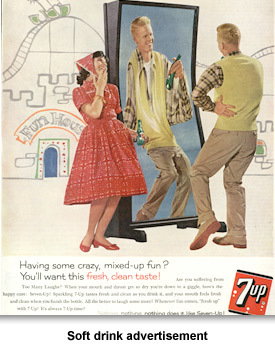
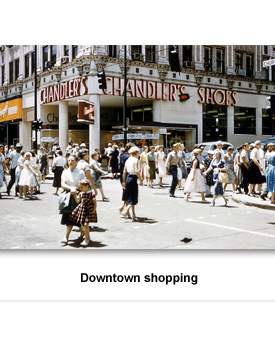
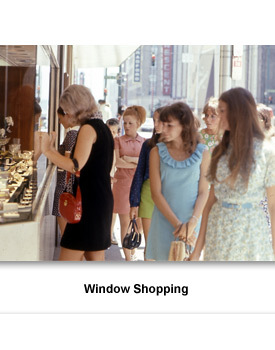
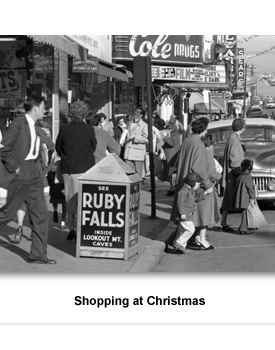
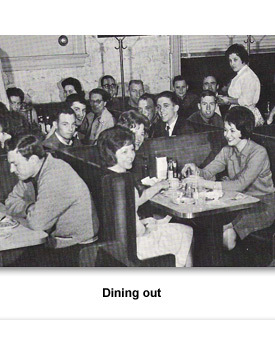
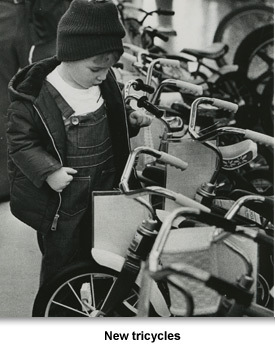
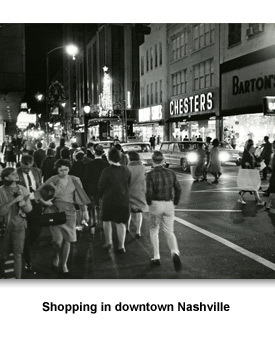
 Sponsored by: National Endowment for the Humanities
Sponsored by: National Endowment for the Humanities